Simon Drake* and Andy Beard on the recent discovery of Paleocene impact ejecta on the Isle of Skye.
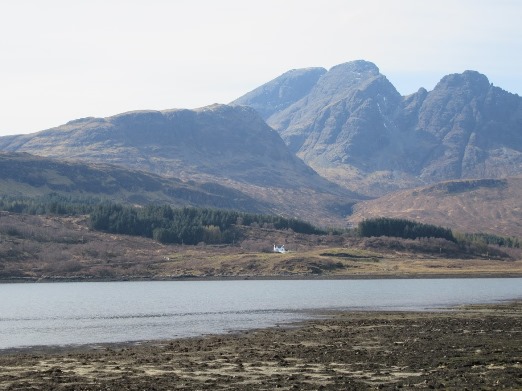
Recent fieldwork on the Isle of Skye has led to the discovery of the extraterrestrially derived mineral vanadium-rich Osbornite (TiVN) within a one-metre thick layer at two separate sites seven kilometres apart.
Picture, right: Site 1 of the meteoritic ejecta deposit at the base of the lowest basalt flows above the white house on the far shores of Loch Slapin. To get to it involved traversing over a forest that had been cut down on very boggy ground. Note Blaven in the background.
To date, this mineral had only been reported as dust collected from the wake of the Wild II comet trail during the 2006 NASA Stardust mission. It had never been reported on Earth before, and therefore could prove an extremely important and interesting find.
Ignimbrite eyes
The story began in 2011 during PhD fieldwork when I was trying to identify silicic ignimbrites on Skye and from there to map and log these deposits. The idea was then to correlate the logs and determine the nature and characteristics of eruptions. From there, I wanted to establish precisely where silicic volcanics fitted into Skye’s volcanological evolution.
I first needed to check the earliest volcanic rocks on the Island, and began mapping with ‘ignimbrite’ eyes on. During this fieldwork, I decided to target the lavas on the Strathaird Peninsula near Torrin and look right at the base. My colleague Andy Beard and I traversed some very awkward ground and located a 1m-thick layer of extremely strange-looking rock beneath these lavas. The rock was buff-coloured and had a streaky fabric, akin to a welded ignimbrite. I’ll refer to it as a meteoritic ejecta deposit (Site 1).
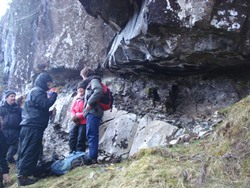
The layer is housed in a pronounced, recessed notch at the base of the An Carnach lava pile on the Strathaird Peninsula. A later sill has chilled between the lowermost part of the meteoritic deposit in the notch and the uppermost Mid-Jurassic sedimentary rocks. By stripping the sill out of the stratigraphy it became clear that the ejecta deposit layer was initially lying on top of Mid-Jurassic sedimentary rocks.
Picture, left: Sampling in 2014: a view of the meteoritic ejecta layer at Site 1 above the sill. Keen first year Birkbeck students helped in bringing samples back.
Fieldwork continued during the summer of the following year and I found a very interesting outcrop seven kilometres away, south of Broadford, near the Neolithic burial site known as Chambered Cairn. Rocks here were designated (on the 1900 Survey map) as Triassic conglomerate. However this outcrop comprises two units, which resemble a pyroclastic deposit: a lower, light-coloured friable unit, full of vesicles, grades up into another unit that looks like a conglomerate and contains basaltic clasts. I’ll refer to both units as meteoritic ejecta deposit (Site 2).
At that stage, we had no idea of the true nature of the rocks at both sites but we did know that both were highly unusual and undocumented. Indeed, Site 2 was out of published stratigraphical context due to the presence of the basalt clast. It could not therefore be Triassic as previously thought.
Unearthly viva
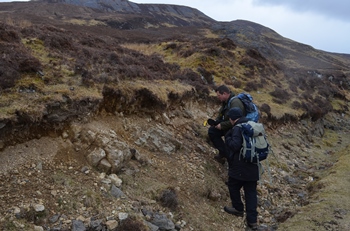
My PhD viva in March 2015 resulted in an interesting discussion with one of the examiners, Dr Adrian Jones from University College London. We debated whether Skye could have been hit by a meteorite, and Adrian’s enthusiasm for the potential of a new impact site was infectious. It was then that I decided to reinvestigate our samples. Probe work followed in the coming months, and a host of exotic minerals emerged from both sites, some of which were not known on Earth.
Picture, right: The authors examining the nature of Site 2: lower unit road cut on B8083 south of Broadford on the Isle of Skye. The Cambo-Ordovician peak of Beinn is seen in the background.
We now had two strange sites that seemed to contradict previous stratigraphical and accepted context. At Site 1, potassium-rich, bentonised ash, lying below the earliest basalts, suggested that the first volcanic outpourings on Skye were silicic and not basaltic as formerly thought. At Site 2, a Paleocene-aged conglomerate was found on top of rocks of Cambrian-Ordovician age - a contact unknown on Skye.
We decided to reinvestigate the samples from Sites 1 and 2 and used three analytical methods. First, thin-sections from both sites were made to determine whether any shock features could be determined from either site under both polarising microscope and electron microprobe. Second, zircons were extracted from samples at both sites with a view to dating using the U-Pb system. Could we date or provide a time bracket when impact occurred?
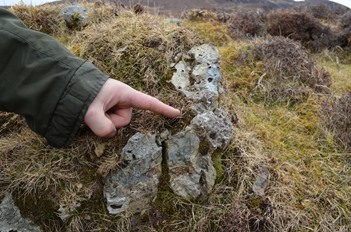 Picture, left:
Picture, left: Paleocene aged lower meteoritic ejecta layer deposit plastered on top of Cambro-Ordovician dolostone (grey) near Site 2. Note the vesicular nature of the buff coloured ejecta deposit (above finger). Very little of this deposit is preserved around the road cut, presumably because of erosion and glaciation.
Third, we employed a method whereby samples were carefully ground down in a hand crusher, sieved, and then exposed to a strong Rare Earth Element magnet to extract any metallic minerals present. This process is laborious, but minimises the chance of cross contamination that may occur in larger crushers. The separated fractions were mounted on slides as polished grain mounts for analysis on an electron microprobe. Minerals with a higher total atomic weight relative to their silicate counterparts appear bright white on an electron microprobe using the backscatter image, whereas silicates generally appear darker grey to black. By this method, metals can be found and analysed for interesting inclusions. So the rule is ‘white = weird’! Importantly, by this method we hoped to find parts of the relict meteorite itself.
Shocked quartz
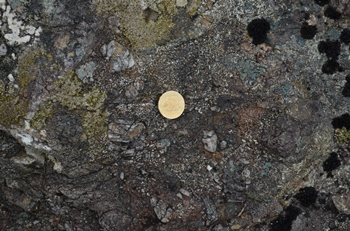
Under the polarising microscope, samples from both sites showed evidence of terrestrial quartz being instantaneously shocked. Planar parallel deformation fractures within quartz occurred commonly. These features are quite easy to spot under high magnification. They stick out, since of course quartz has no cleavage. We also noticed the presence of diaplectic quartz glass, which was produced instantaneously upon impact. Here, the criss-cross effect of pseudo-cleavage was produced without melting of the quartz, by a solid-state transformation, which is known to occur at pressures of at least 35GPa.
Picture, right: The nature of Site 2 upper unit which had formerly been mapped on the 1900s map as Triassic Conglomerate. Note the presence of basaltic lithic lapilli in close proximity to the coin at 3 and 6 o’clock.
The presence of shocked quartz alone is not compelling evidence of impact. Controversy surrounds the reporting of shocked quartz in impact-related studies. We could already hear the counter arguments: ‘They’re scratches made during the slide-making process’ or ‘the intersection angles are not convincing’.
However, zircons were showing interesting features - which was far more heartening. At extreme shock pressures of 30GPa, near Earth’s surface, zircon can in part retain the same chemistry but have a different crystal structure. It can instantaneously transform to its high pressure counterpart, reidite. To show how extreme this near-surface pressure really is, inclusions in diamonds form over time as quartz changes to coesite at depths ≥100km, and at pressures of 2-3Gpa. The presence of reidite provided strong evidence that we were on the right track and that it was increasingly likely that a meteorite had fallen on Skye; but more evidence was necessary for a watertight case.
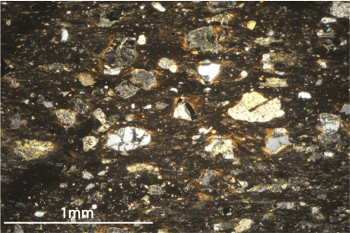
Returning to the electron microprobe, we examined the irons to try and find part of the meteorite itself. Native iron fragments were sporadically present in samples from both sites and contained rare vanadium rich osbornite (TiVN) in close association with barringerite (Fe,Ni)2P inclusions. Native iron (also known as telluric iron) is extremely rare on Earth and only found in its metallic form, rather than as an ore. The only documented telluric iron deposit is in Greenland, at Disko Island, which itself is near a meteorite impact site. So what was native iron doing on Skye with TiVN inside it?
Picture, left: View under crossed Nicols of the nature of the strong matrix fabric from Site 1 which resembles, in part, a welded ignimbrite in that much of the matrix is deflected strongly around quartz crystals and lithic lapilli.
Solar nebula
This mineral is a refractory one, formed at temperatures in excess of 3000°C. It is believed to have been produced within the inner solar nebula close to the proto-sun, and then, transported outwards where it was accreted onto a growing planetary body. Interestingly, within our samples we a found niobium-rich osbornite (TiNbN) - the first recorded example of this mineral. The osbornite was to prove extremely important since it formed part of the meteorite itself. Large meteorites usually vaporise upon impact with Earth and therefore only Earth rocks show evidence of impact. To find a meteorite impact deposit site with part of the impactor itself present is highly unusual and has only previously been reported from the Chicxulub crater in Mexico.
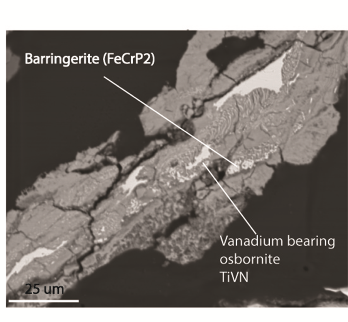 Picture, right:
Picture, right: Backscatter electron microprobe image of Vanadium rich osbornite (TiVN) in close association with barringerite. Prior to the Paleocene Skye meteorite strike, TiVN had only been recovered as dust from the Wild II comet by NASA in 2006
While the presence of TiVN provides compelling evidence of extra-terrestrial derivation, we also found barringerite in samples from both sites. This mineral has been found on Earth in phosphide and Cu-Ni sulphide deposits. Neither of these types of deposit is found on Skye. Barringerite was named after Daniel Barringer (1860-1929) the mining engineer who first proved the meteoritic origin of the Meteor (Barringer) Crater in Arizona, where the mineral was first found.
At both Skye sites, rare, microscopic spherules of native iron are evident within the rock matrix. The native iron cores of the spherules are surrounded by iron-rich silicate glass. The shape, texture and chemistry of these spherules strongly suggest that they were formed very rapidly in conditions of very low oxygen fugacity. Such conditions can occur on Earth and iron-cored spherules are found within some ignimbrites. However, it is difficult to convincingly ascribe native iron cores to a terrestrial process. Moreover, the iron spherules we have found in the Skye deposits are extremely similar, texturally and chemically, to those found in the Wabar Meteorite Crater (Saudi Arabia). Also, the minerals baddeleyite and alabandite are present within the matrix at both Skye sites. Although not exclusively extra-terrestrial, baddeleyite has been reported from achondrite meteorites. Such meteorites resemble terrestrial basalts. Alabandite has also been found in the very rare meteorite group the enstatite chondrites.
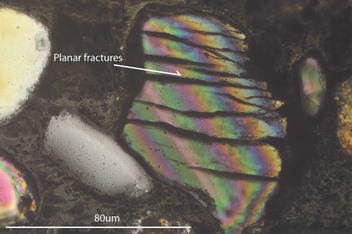
Picture, left: A zircon grain displaying planar fractures from Site 1. This grain has also in part been converted to zircon’s high pressure polymorph reidite. The presence of reidite provides compelling evidence of instantaneous extreme pressure (≥ 30 GPa) shocking.
Conundrum
We now had a conundrum - compelling mineralogical evidence for meteorite impact in a layer just beneath the oldest volcanic rocks on Skye, which appeared very similar to another layer seven kilometres away. We also had a fragment of the meteorite itself. The find was surely going to be controversial. Skye holds a special place in geologists’ hearts. Much of our knowledge of igneous processes comes from Skye and the British Paleogene Igneous Province (BPIP) (from the Inner Hebrides to Northern Ireland). Most workers today accept volcanism on Skye and the BPIP was initiated by a mantle plume that melted into the base of ancient continental crust. This event was short-lived (between 60-55Ma). So where did an impact fit in the picture? We needed to try and date the impact.
Zircons from Site 1 were dated and clustered around the Archean and Proterozoic. Rocks of these ages on Skye at the time of impact would have been Lewisian Gneiss and Torridonian sandstone. The impact would have scavenged these rocks out of the subsurface and incorporated their zircons into our impact deposit. Importantly, some of our zircons were Triassic in age, which meant that our deposit could not be part of the mainland 1.2 Ga Stac Fada meteorite impact event. The lack of Paleocene-aged zircons in our deposits suggested that there were none available for incorporation at the time of impact.
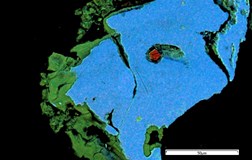 Image, right:
Image, right: An elemental X-ray map of a Niobium rich osbornite (TiNbN) crystal (red) surrounded by a terrestrially weathered FeO (green) and enclosed within native iron (blue.)
The impact must therefore have taken place very early on in Skye’s volcanic history. We knew that the overlying lavas formed part of the Skye Main Lava Series and had been dated as 60.00 ±0.23Ma. The impact must have happened before this date, since Site 1 was immediately below the base lavas. We had the basaltic clast from Site 2 dated at 61.54 ±0.42Ma using the Ar-Ar method. The date of this basalt clast locked in the earliest date that a meteorite impact could have taken place.
But the existence of the basalt within the deposit showed that some igneous activity must have been going on before the impact event. It is possible that this basalt could be part of a lava, or be the fine-grained margin of a shallow intrusive. There is no way of knowing. Yet, the presence of basaltic clasts brackets the date of meteorite impact between 61.54 ±0.42Ma and 60.00 ±0. 23Ma. Interestingly, the basaltic clast is one of the oldest igneous rocks known from the BPIP.
The discovery of the impact layers suggests that a meteorite might have acted as a driver for volcanism on Skye up to 62 million years ago. The meteorite itself must have been highly reduced, because of the presence of osbornite in its different varieties. Taking everything into account the most likely candidate for the type of meteorite is an enstatite chondrite.
Future research
We need to try and establish the extent of these impact deposits within the BPIP. We have located three new Skye sites including a site adjacent to Loch Skavaig in the Cuillin Centre. This is quite a difficult site to reach and only accessible by boat.
We need to investigate whether the Skye meteorite ejecta deposits were deposited in a similar manner to terrestrial ignimbrites. The flow mechanics of terrestrial ignimbrites are highly complex, since high-concentration currents entraining large components frequently erode into the dusty layers they have previously deposited. Similarly, hot ash and pumice can ascend and shoot off from the main current in a ‘decoupling’ event. What this means is that ignimbrites, and probably meteorite ejecta deposits, do not commonly show a true vertical sequence of the whole eruption or impact record. It can therefore be very difficult to determine whether deposits are proximal or distal to an impact site if a crater is not present.
We will do a lot more exploration for this impact deposit, ideally further afield in the wider North Atlantic Igneous Province (NAIP). The zircon age clusters we have from both sites of Skye marry up well with zircon ages in Scandanavia, Greenland and Canada within the NAIP. This means that any surviving crater could theoretically be located in several places within the Northern Hemisphere. At present we don’t know if a crater exists for the Skye impact event or, where it is.
This work has attracted a lot of interest on Skye, as well as within the scientific community and the media. We are planning to give a public lecture on the Isle in March this year (and will donate all proceeds to the Skye Mountain Rescue). I am really looking forward to giving something back to the place that has enthused me so much for volcanism (and given me so many midge bites!). Indeed, the Isle of Skye holds a special place in my life since I got married on the side of the Eastern Red Hills during my 2010 fieldwork season.
The late doyen of Hebridean geology, Henry Emeleus, spoke to me during my PhD fieldwork about the region where we found site 2. He said “That corner is mapped wrongly. If you sort it out, you’ll have a much better picture of the geology around here.”. Tragically, he died before we published our paper so never realised how prophetic his words really were.
*Simon Drake gratefully acknowledges funding from the Geological Society of London, Annie Greenly mapping fund which assisted greatly in this study. Birkbeck College, University of London.
Further reading
-
M ChI, H A Ishii, S B Simon, J P Bradley, Z Dai, D Joswiak, N D Browning and G Matrajt 2009. The origin of refractory minerals in comet 81P/WILD 2: 221, Geochimica et Cosmochimica Acta, v. 73, p. 7150–7161.
-
S M Drake, A D Beard, A P Jones., D J Brown, A D Fortes, I L Millar, A Carter, J Baca and H Downes 2017. Discovery of a meteoritic ejecta layer containing unmelted impactor fragments at the base of Paleocene lavas, Isle of Skye, Scotland. Geology, gold open access https://doi.org/10.1130/G39452.1